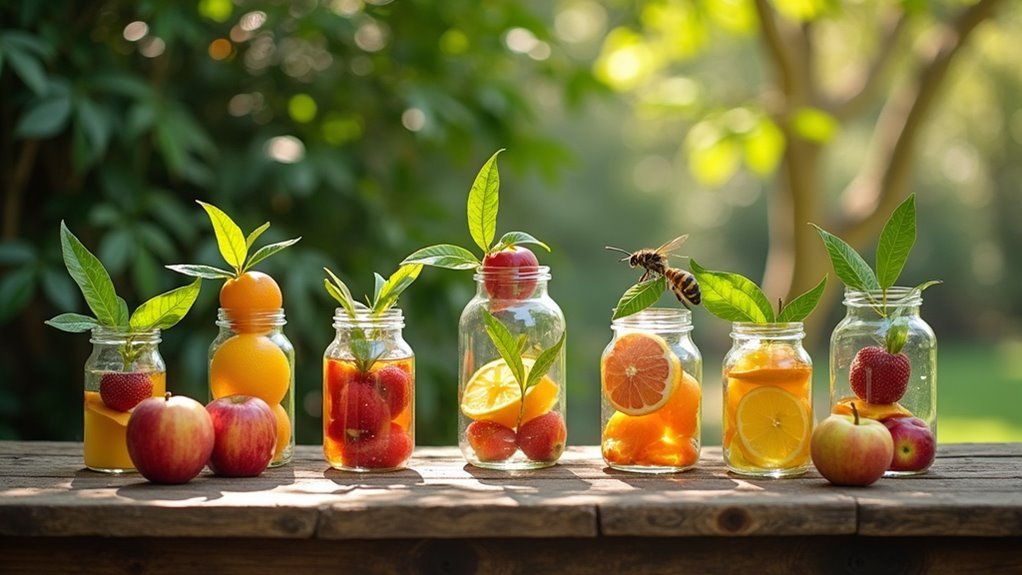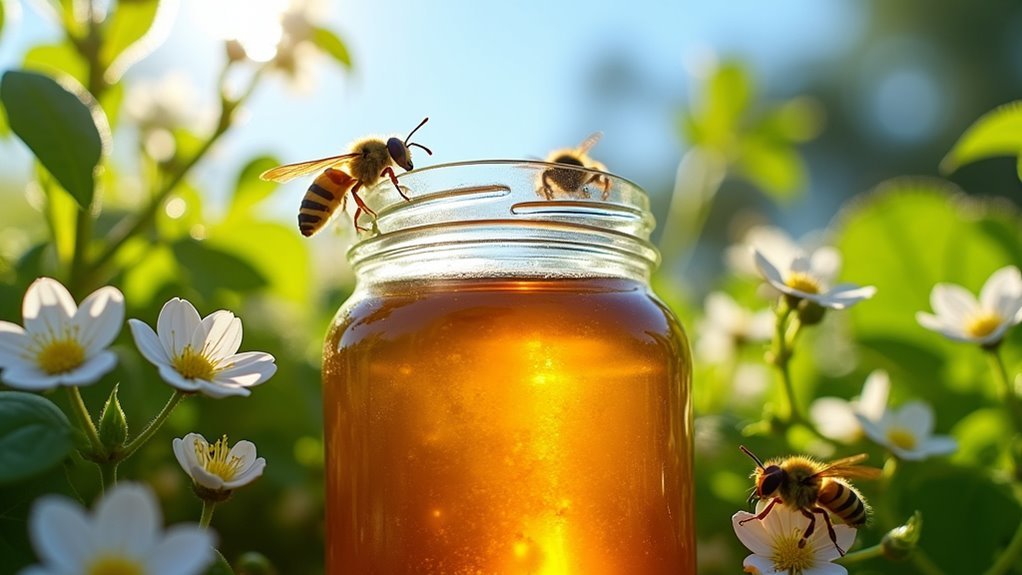You can create highly effective natural wasp traps using a simple 2-liter plastic bottle, cutting tools, and strategic bait selection. Cut the bottle to form a funnel entrance, then fill it with seasonal baits—protein sources in spring for feeding larvae, or sugary solutions in late summer when wasps crave sweets. Position traps 5-6 feet high near activity zones like garbage bins, replacing bait weekly for best results. These eco-friendly methods offer thorough strategies that protect your family while supporting beneficial insects.
Why Choose Natural Wasp Control Methods

While chemical wasp sprays promise quick results, natural wasp control methods offer a safer, more sustainable approach that protects both your family and the environment.
These methods provide a non-toxic alternative that won’t harm beneficial insects like bees and butterflies, which are important pollinators essential to your garden’s health.
Homemade wasp traps prove remarkably effective while keeping costs low. You’ll use common household items like vinegar and dish soap, creating traps from recycled plastic bottles that reduce waste.
Creating effective wasp traps from everyday household supplies like vinegar and soap offers an affordable, waste-reducing solution for natural pest control.
Unlike chemical sprays, natural methods target wasps specifically without contaminating your outdoor spaces or posing risks to children and pets.
You’re also supporting sustainability by choosing eco-friendly solutions that work with nature rather than against it.
Essential Materials for DIY Wasp Traps
Creating your own wasp trap requires just a few simple materials you likely already have around your home.
You’ll need these basic components to construct an effective trap:
- Empty plastic bottle – A 2-liter soda bottle works perfectly for the trap’s main structure
- Cutting tools – Sharp scissors or knife for creating the entrance hole
- Marking supplies – Permanent marker to mark your cutting lines accurately
- Hanging materials – Wire or string to position your trap strategically
For the bait, you’ll use either protein sources like lunch meat or sugary solutions depending on the season.
Adding apple cider vinegar helps deter beneficial bees, while a few drops of dish soap prevents trapped wasps from escaping by reducing surface tension.
Understanding Wasp Behavior and Seasonal Preferences

To maximize your trap’s effectiveness, you need to understand how wasp preferences change throughout the year. Understanding wasp behavior is essential for successful trapping, as their dietary needs shift dramatically with the seasons.
| Season | Preference | Reason |
|---|---|---|
| Spring/Early Summer | Protein sources | Building nests, feeding larvae |
| Late Summer/Fall | Sugary substances | Preparing for winter |
| Year-round | Species variation | Yellow jackets more aggressive than paper wasps |
Early in the season, wasps actively seek protein sources like meat scraps to nourish their developing larvae. As summer progresses, they’ll switch to sugary substances such as overripe fruits and sweet liquids. This behavioral shift directly impacts your bait selection timing. You’ll achieve better results using protein-based baits during nest-building periods and sugar baits during late summer preparation phases.
Step-by-Step Bottle Trap Construction
Building your own wasp trap requires just a few simple materials and takes less than 10 minutes to complete.
You’ll need an empty plastic soda bottle, permanent marker, knife or scissors, and your chosen bait mixture.
- Mark and cut the bottle – Draw a line around the neck just below the taper, then carefully cut along this line using sharp scissors or a knife.
- Create the funnel entrance – Remove the bottle cap and invert the top portion into the bottom section, forming a funnel that wasps can enter but struggle to escape.
- Add effective bait – Fill with 3/4 cup white vinegar, 2 tablespoons sugar, and 1 teaspoon salt for the most important part of your DIY wasp trap’s success.
- Install hanging mechanism – Punch two holes at the top and thread wire through for secure placement.
Effective Bait Recipes for Different Seasons

While constructing the perfect trap matters, your bait selection determines whether you’ll catch wasps or watch them fly right past your carefully crafted device.
Effective bait recipes change with seasons based on wasps’ dietary needs.
During early spring through early summer, use protein-based baits like lunch meat or hamburger. Wasps actively seek protein to feed their developing larvae during this period.
Switch to sugary options as late summer and fall arrive. Sugar water, jam, or fruit juice work exceptionally well when wasps crave sweets.
Never use honey since it attracts beneficial bees. Instead, enhance your bait by adding vinegar to deter honeybees and including dish soap drops to eliminate surface tension.
Replace bait weekly to maintain its attractiveness throughout the trapping season.
Strategic Placement for Maximum Trap Success
Even with the most irresistible bait, poorly placed traps won’t deliver results.
Strategic placement determines whether you’ll achieve trap success or waste your efforts. Wasps follow predictable patterns, making location selection critical for effective capture.
Here’s how to position your traps for maximum effectiveness:
- Target high-activity zones – Place traps near fruit trees, garbage bins, and flower gardens where wasps naturally congregate.
- Maintain proper height – Hang traps 5-6 feet off the ground since wasps prefer elevated navigation routes.
- Create distance from dining areas – Position traps away from picnic tables to draw wasps away from your outdoor meals.
- Use multiple trap stations – Space several traps strategically around your property to capture wasps attracted to different areas.
Choose shaded locations during hot weather, as wasps remain more active in cooler environments.
Alternative Trap Designs and Techniques
Why settle for basic bottle traps when countless creative designs can boost your wasp-catching success?
You’ll find that rectangular plastic food containers work exceptionally well when filled halfway with very soapy water. The soap breaks surface tension, causing wasps to drown upon landing.
For an innovative protein-based approach, hang a small chicken bone over your soapy water container. Wasps are naturally drawn to protein sources, especially during early spring. These traps are easy to make and highly effective.
You can also create hanging traps using plastic bottles with raised dimples. Cut a 3/4-inch hole in the bottom, then fill with jam dissolved in water.
Add a teaspoon of vinegar to deter honeybees while maintaining wasp attraction. Customize your traps with decorative twine and beads to blend seamlessly into your environment.
Maintenance and Safety Considerations
Creating effective wasp traps represents only half the battle—proper maintenance and safety protocols determine your long-term success and personal protection.
Building effective wasp traps is just the beginning—consistent maintenance and proper safety measures ensure lasting success and personal protection.
Regular maintenance keeps your traps functioning efficiently while protecting you from wasps. Follow these essential safety guidelines:
- Weekly inspections – Check traps at least once weekly to remove dead wasps and refresh bait for continued effectiveness.
- Strategic placement – Position traps securely in low-traffic areas where you won’t accidentally disturb active wasps.
- Solution replacement – Change trapping liquid frequently to prevent odors and maintain bait attractiveness.
- Protective gear – Always wear gloves during maintenance to prevent stings and direct contact.
If you’re allergic to wasp stings, exercise extra caution when handling traps. Proper safety measures guarantee your natural pest control remains effective without compromising your wellbeing.
Deterrent Strategies to Complement Trapping
While natural traps effectively capture wasps, you can strengthen your defense by adding strategic deterrents around your property.
Position oscillating fans near dining areas to create wind currents that make it difficult for wasps to approach and hover around food.
You’ll also want to hang fake hornet nests in visible locations, as wasps are territorial creatures that typically avoid areas where they believe other colonies have already established themselves.
Oscillating Fans as Deterrents
Although wasps are agile fliers, they struggle against strong, consistent air currents that disrupt their navigation and make hovering nearly impossible.
Oscillating fans serve as effective deterrents by creating wind barriers that make it difficult for wasps to approach your outdoor spaces.
These natural deterrents work best when strategically positioned:
- Near dining areas – Place fans close to tables where food and drinks attract wasps.
- Around gathering spaces – Position multiple fans to create overlapping wind currents.
- During peak activity – Run fans continuously during late summer when wasp activity intensifies.
- Alongside traps – Combine fans with your existing trap setup for enhanced protection.
You’ll find oscillating fans particularly useful in open spaces where wasps typically forage, as the constant airflow creates an inhospitable environment without requiring chemical insecticides.
Fake Nest Placement
Moving beyond mechanical deterrents, you can exploit wasps’ territorial nature with strategically placed fake nests.
These decoy structures effectively deter wasps from establishing colonies in your yard, as they’ll perceive the area as already claimed territory and typically abandon their settlement plans.
You can purchase commercial fake nests or craft your own using brown paper bags that mimic real wasp nest appearances.
For maximum effectiveness, hang these decoys at least 10 feet high in sheltered locations where they’re visible but protected from weather damage.
The territorial instinct that drives wasps away from perceived competing colonies makes this strategy particularly powerful.
Combine fake nests with other deterrent methods like removing food sources and using fans to create a thoroughly unwelcoming environment.
Ecological Benefits of Non-Toxic Wasp Management
When you choose non-toxic wasp management methods over chemical pesticides, you’re supporting a delicate ecological balance that benefits your entire garden ecosystem.
These beneficial wasps play significant roles that extend far beyond what most gardeners realize.
Your decision to use homemade traps instead of toxic chemicals creates multiple environmental advantages:
- Pollination support – You’ll preserve essential wasp species that pollinate specific plants, including figs that depend entirely on wasps for reproduction.
- Natural pest control – Paper wasps you encourage will hunt caterpillars and aphids, reducing garden damage naturally.
- Wildlife protection – You’ll eliminate pesticide residues that harm other beneficial insects and wildlife.
- Biodiversity enhancement – Your eco-friendly approach supports various insect species important to local ecosystems.
Frequently Asked Questions
What Is the Most Effective Homemade Wasp Trap?
Cut a plastic soda bottle’s top off and invert it into the bottom, creating a funnel. You’ll bait it with white vinegar, sugar, salt, and dish soap for maximum effectiveness.
Why Does Dawn Dish Soap Kill Wasps?
Dawn dish soap kills wasps by breaking down water’s surface tension, causing them to drown when they land. You’ll see the soap coats their exoskeleton, preventing wing movement and flight escape.
Does Vinegar Really Kill Wasps?
Vinegar doesn’t directly kill wasps, but you’ll find it disrupts their flight when mixed with soapy water. You can use it effectively in homemade traps alongside dish soap to create drowning effects.
What Is the Best Home Remedy to Kill Wasps?
You’ll find soap and water works best for killing wasps instantly. Spray it directly on them or their nests – the soap clogs their breathing pores, eliminating them immediately without harsh chemicals.
In Summary
You’ve now got the knowledge to tackle wasp problems naturally and effectively. By understanding their behavior, building strategic traps, and using seasonal baits, you’ll control these pests without harmful chemicals. Remember to maintain your traps regularly and combine them with deterrent strategies for best results. You’re not just protecting your family—you’re preserving beneficial insects and supporting a healthier ecosystem. Start implementing these methods today for immediate relief.





Leave a Reply